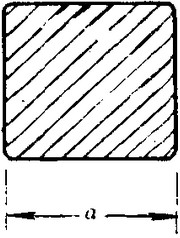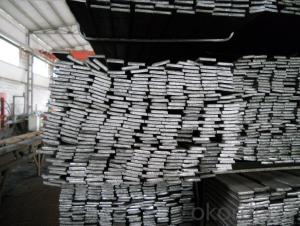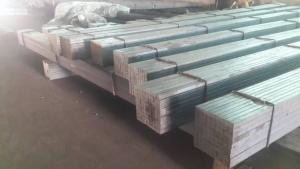High Quality GB Standard Steel Square Bar 26mm-30mm
- Loading Port:
- Tianjin
- Payment Terms:
- TT OR LC
- Min Order Qty:
- 25 m.t
- Supply Capability:
- 10000 m.t/month
OKorder Service Pledge
OKorder Financial Service
You Might Also Like
Product Description:
We offer Square Steel Bar with grade Q195 / Q235
Specifications of Square Steel Bar:
-Standard: GB,
-Grade: Q195/Q235 or equivalent.
Chemical Composition:
-Chemical Composition. Q195
Standard | Grade | Element (%) | ||||
GB | Q195 | C | Mn | S | P | Si |
0.06~0.12 | 0.25~0.50 | ≤0.050 | ≤0.045 | ≤0.30 | ||
-Chemical Composition. Q235
Standard | Grade | Element (%) | ||||
GB | Q235B | C | Mn | S | P | Si |
0.12~0.20 | 0.30~0.70 | ≤0.045 | ≤0.045 | ≤0.30 | ||
Measures and Tolerances of Square Steel Bar:

(The section of Square Steel Bar)
-The length of a side and the theoretical weight of Square Steel.
Length of a side(a, mm) | Theoretical weight(kg/m) | Length of a side(a, mm) | Theoretical weight(kg/m) |
6 | 0.283 | 32 | 8.04 |
7 | 0.385 | *33 | 8.55 |
8 | 0.502 | 34 | 9.07 |
9 | 0.636 | *35 | 9.62 |
10 | 0.785 | 36 | 10.17 |
11 | 0.950 | 38 | 11.24 |
12 | 1.13 | 40 | 12.56 |
13 | 1.33 | 42 | 13.85 |
14 | 1.54 | 45 | 15.90 |
15 | 1.77 | 48 | 18.09 |
16 | 2.01 | 50 | 19.63 |
17 | 2.27 | 53 | 22.05 |
18 | 2.54 | *55 | 23.6 |
19 | 2.82 | 56 | 24.61 |
20 | 3.14 | *58 | 26.4 |
21 | 3.46 | 60 | 28.26 |
22 | 3.80 | 63 | 31.16 |
*23 | 4.15 | *65 | 33.17 |
24 | 4.52 | *68 | 36.3 |
25 | 4.91 | 79 | 38.49 |
26 | 5.30 | 75 | 44.16 |
*27 | 5.72 | 80 | 50.24 |
28 | 6.15 | 85 | 56.72 |
*29 | 6.60 | 90 | 63.59 |
30 | 7.06 | 95 | 70.85 |
*31 | 7.54 | 100 | 78.50 |
Notes:
1, The theoretical weights in the list, base on the density of 7.85 g/cm3.
2, The numbers with *mean that they are not regulars or we don’t offer them.
-The allowed tolerance of Square Steel:
Length of a side(mm) | Allowed Tolerance | ||
Group1 | Group2 | Group3 | |
5.5~7 | ±0.20 | ±0.30 | ±0.40 |
7~20 | ±0.25 | ±0.35 | ±0.40 |
20~30 | ±0.30 | ±0.40 | ±0.50 |
30~50 | ±0.40 | ±0.50 | ±0.60 |
60~80 | ±0.60 | ±0.70 | ±0.80 |
80~110 | ±0.90 | ±1.0 | ±1.1 |
110~150 | ±1.2 | ±1.3 | ±1.1 |
150~190 | ―― | ―― | ±2.0 |
190~250 | ―― | ―― | ±2.5 |
Usage/Applications of Steel Square Bar:
-The Square Steel is normally used as structure steel.
-Row material for other structure steel like steel angles, channels, I-beams, H-beams, etc…
Packaging & Delivery of Steel Square Bar:
-Packing Detail: The products can be packed in bundles by steel wires.
-Marks:
1, Tag marks: the tag marks will be tied up to each bundle of the products. The information is usually including supplier’s logo and name, product name, made in China, products’ specifications, the painted color and other information requested by customers.
2, Color marks: we will paint both ends of the bundles of these products to make sure that they are more evident. It’s will be more convenient for the customers to distinguish them at the destination port.
-Delivery Detail: 30~45 working days after receive buyer’s T.T. or L/C.
Transportation:
-The products can be delivered by bulk vessel or by container. As for container, products with the length of 6m will be loaded in 20’ container, with 9m or 12m, in 40’ container.
-The maximum quantity of loading of container is 25 tons.
-The products usually are transported to the nearest port from the production place.
- Q:How do you use a steel square to determine the angle of a valley rafter cut?
- To use a steel square to determine the angle of a valley rafter cut, you can follow these steps: 1. Place the steel square on the edge of the valley rafter, with one leg of the square aligned with the top edge of the rafter and the other leg extending towards the bottom edge. 2. Slide the square along the rafter until the bottom leg intersects with the roof surface where the valley rafter will be attached. 3. Once the square is properly positioned, mark the angle indicated by the intersection of the square's legs on the rafter. 4. Use a protractor or the angle measuring feature on the steel square to measure the marked angle accurately. 5. Transfer the measured angle onto the valley rafter by aligning the square's legs with the top and bottom edges of the rafter and marking the angle accordingly. 6. Finally, use a saw or other appropriate tools to cut along the marked angle on the valley rafter to achieve the desired cut. Using a steel square in this manner allows you to determine and transfer the correct angle for cutting the valley rafter, ensuring a precise fit and appropriate joint when installing it in the roof structure.
- Q:What are some common techniques for using a steel square in cabinetry?
- Some common techniques for using a steel square in cabinetry include measuring and marking 90-degree angles, checking for squareness of corners, transferring measurements and dimensions accurately, and ensuring the alignment of cabinet components during assembly.
- Q:How do you maintain a steel square?
- To maintain a steel square, it is important to keep it clean and free from rust. After each use, wipe it down with a clean cloth to remove any dirt or debris. To prevent rust, you can apply a thin layer of oil or a rust inhibitor on the steel surface. It is also recommended to store the square in a dry place to avoid any moisture buildup. Regular inspection for any signs of damage or wear is necessary, and if needed, the square should be calibrated or replaced.
- Q:Can a steel square be used for checking the plumbness of a support beam?
- No, a steel square is not typically used for checking the plumbness of a support beam. A level or plumb bob would be more suitable for this task.
- Q:How do you use a steel square to determine the height of a countertop?
- In order to determine the height of a countertop using a steel square, several simple steps must be followed: 1. Begin by placing the steel square on the countertop, ensuring that it aligns with one of the corners. The long side of the square should rest on the surface of the countertop. 2. Proceed to extend the square vertically until it reaches the desired height that you wish to measure. It is crucial to ensure that the square is completely perpendicular to the countertop surface. 3. Once the square is correctly positioned, employ a tape measure to gauge the distance from the bottom of the square to the surface of the countertop. This measurement will provide you with the precise height of the countertop. 4. To guarantee accuracy, repeat this process on each corner of the countertop. Measuring multiple points is important in order to account for any unevenness or irregularities on the countertop surface. By utilizing a steel square and adhering to these steps, you will be able to accurately ascertain the height of a countertop. This technique proves especially beneficial when precise measurements are necessary for the installation of appliances, cabinets, or any other elements that require a specific countertop height.
- Q:How do you use a steel square to find angles for compound bevel mitered corners?
- To use a steel square to find angles for compound bevel mitered corners, you would typically start by placing the square against the workpiece and aligning its edges with the edges of the corner. Then, you can use the markings on the square to measure and determine the angles required for the compound bevel. This involves adjusting the square to find the correct angles for both the bevel and miter cuts, ensuring a precise fit for the corner joint.
- Q:How do you use a steel square to determine the angle of a miter gauge cut?
- To use a steel square to determine the angle of a miter gauge cut, you need to align the square's long side with the miter gauge and the short side with the workpiece. Then, adjust the miter gauge until the square's edge is parallel to the desired angle of the cut. This allows you to accurately set the miter gauge to achieve the desired angle for your cut.
- Q:Can a steel square be used for marking and scribing?
- Yes, a steel square can be used for marking and scribing.
- Q:How do you use a steel square to measure and mark 101.25-degree angles?
- To use a steel square to measure and mark a 101.25-degree angle, you would need to follow these steps: 1. Start by placing the long side of the steel square, also known as the blade, flat against the edge of the material you want to mark. Ensure the square is aligned properly and securely against the edge. 2. Next, locate the degree scale on the square. This scale is usually found on the inside of the square near the corner where the blade and the tongue meet. 3. Look for the 90-degree mark on the degree scale. This is usually the largest mark on the scale and represents a right angle. Align the 90-degree mark with the edge of the material. 4. Now, locate the 0-degree mark on the scale. This is typically the starting point of the scale closest to the blade. It represents a straight angle. Align the 0-degree mark with the edge of the material as well. 5. With the 90-degree mark and the 0-degree mark aligned, you can now find the 101.25-degree mark on the scale. This might require some estimation, as most steel squares do not have specific markings for angles beyond 90 degrees. 6. Once you have identified the approximate position for 101.25 degrees, make a small mark on the material at that point. You can use a pencil or a scribe to ensure accuracy. 7. To double-check your measurement, you can use the square to draw a line through the marked point. This line should be at a 90-degree angle to the edge of the material. If the line is not perpendicular, you may need to readjust your measurement and mark. Remember, using a steel square to measure and mark angles beyond 90 degrees may require some estimation and accuracy may vary. It is always advisable to use a protractor or angle measuring tool for more precise measurements if available.
- Q:How do you use a steel square to measure and mark perpendicular lines?
- To use a steel square to measure and mark perpendicular lines, align one edge of the square with the reference line or edge. Then, ensure that the other edge is perpendicular to the reference line by checking if it forms a 90-degree angle. Once the square is properly aligned, use a pencil to mark the perpendicular line along the edge of the square.
1. Manufacturer Overview |
|
|---|---|
| Location | |
| Year Established | |
| Annual Output Value | |
| Main Markets | |
| Company Certifications | |
2. Manufacturer Certificates |
|
|---|---|
| a) Certification Name | |
| Range | |
| Reference | |
| Validity Period | |
3. Manufacturer Capability |
|
|---|---|
| a)Trade Capacity | |
| Nearest Port | |
| Export Percentage | |
| No.of Employees in Trade Department | |
| Language Spoken: | |
| b)Factory Information | |
| Factory Size: | |
| No. of Production Lines | |
| Contract Manufacturing | |
| Product Price Range | |
Send your message to us
High Quality GB Standard Steel Square Bar 26mm-30mm
- Loading Port:
- Tianjin
- Payment Terms:
- TT OR LC
- Min Order Qty:
- 25 m.t
- Supply Capability:
- 10000 m.t/month
OKorder Service Pledge
OKorder Financial Service
Similar products
New products
Hot products
Related keywords



























